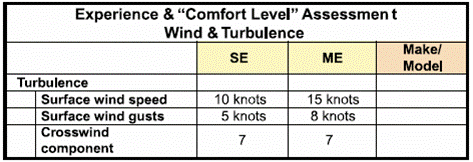|
Ceiling and visibility are the most obvious conditions to consider in setting personal
minimums, but it is also a good idea to have personal minimums for wind and turbulence.
As with ceiling and visibility, the goal in this step is to record the most challenging wind
conditions you have comfortably experienced in the last six to 12 months --
not necessarily the most challenging wind conditions you have managed to survive without
bending an airplane. As shown in the chart, you can record these values for category and
class, for specific make and model, or perhaps both.

In addition to winds,your "comfort level" inventory should also include factors
related to aircraft performance. There are many variables, but start by completing the chart
with reference to the aircraft and terrain most typical for the kind of flying you do most.
Remember that you want to establish a safety buffer, so be honest with yourself. If you have
never operated to/from a runway shorter than 5,000 feet, the "shortest runway" box
should say 5,000 feet. We will talk more about safe ways to extend personal minimums a bit
later.

|


